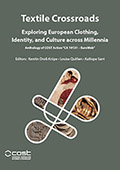Center, Textile Research

Textile Crossroads: Exploring European Clothing, Identity, and Culture across Millennia
Date of this Version
2024
Document Type
Article
Citation
In Textile Crossroads: Exploring European Clothing, Identity, and Culture across Millennia. Anthology of COST Action “CA 19131 – EuroWeb”. Kerstin Droß-Krüpe, Louise Quillien, & Kalliope Sarri, Editors. Zea Books, Lincoln, Nebraska, 2024. . DOI: 10.32873/unl.dc.zea.1802
Abstract
In the late 20th century, the study of western science was dominated by a philosophical approach to evidence as text and meaning. In archaeology, material culture was treated like text, to be read through systems of signs, symbols, and indices put together in syntax. For studies of dress, this was influential in understanding dress as a cognitive system compiled to create identities and meaning. In this approach, textiles, fastenings, hairstyles, and gestures are presented as signs and symbols used to form a statement about identity, to be read by others. There was a focus on the visuality of dress and garments as non-verbal communication media, which was an important advance in studies of dress. Around the turn of the millennium, this position shifted. Critics of the textual approach argued that by emphasizing the cognitive experience, science had lost touch with the physicality of the world. In this turn to the senses, objects are physical matter and perceived through the senses; these sensations are the basis of actions and reactions. In addition, these sensations are not merely natural capabilities, they are learned and cultural. Archaeologists began to explore approaches where evidence was grounded in the sensory approaches, first through phenomenology, then as sensory archaeology. 6 The sensory approach to the past has since flourished.7 The sensory turn has important implications for the study of dress and identities. Where previously the visual sense as non-verbal communication predominated, sensory approaches draw on the full range of senses. Together with visuality and sound, touch (haptics), movements, body language, and gesture are factors in how dress is perceived. Sensations of full garment ensembles are created and cultural — soft cloth versus sharp and spiky metals, weight, elasticity or non-elasticity, and many more. The question is how to investigate that on the basis of the archaeological sources for dress. To address this challenge, in this paper we explore high-status women’s dress of the 8th to 4th centuries BC in the Mediterranean and Central Europe from a sensory perspective.
Included in
Ancient History, Greek and Roman through Late Antiquity Commons, Archaeological Anthropology Commons, Classical Archaeology and Art History Commons, Classical Literature and Philology Commons, Eastern European Studies Commons, European History Commons, European Languages and Societies Commons, Fiber, Textile, and Weaving Arts Commons, History of Science, Technology, and Medicine Commons, Human Geography Commons, Museum Studies Commons, Place and Environment Commons, Social and Cultural Anthropology Commons, Women's Studies Commons


Comments
Copyright © 2024 by the authors